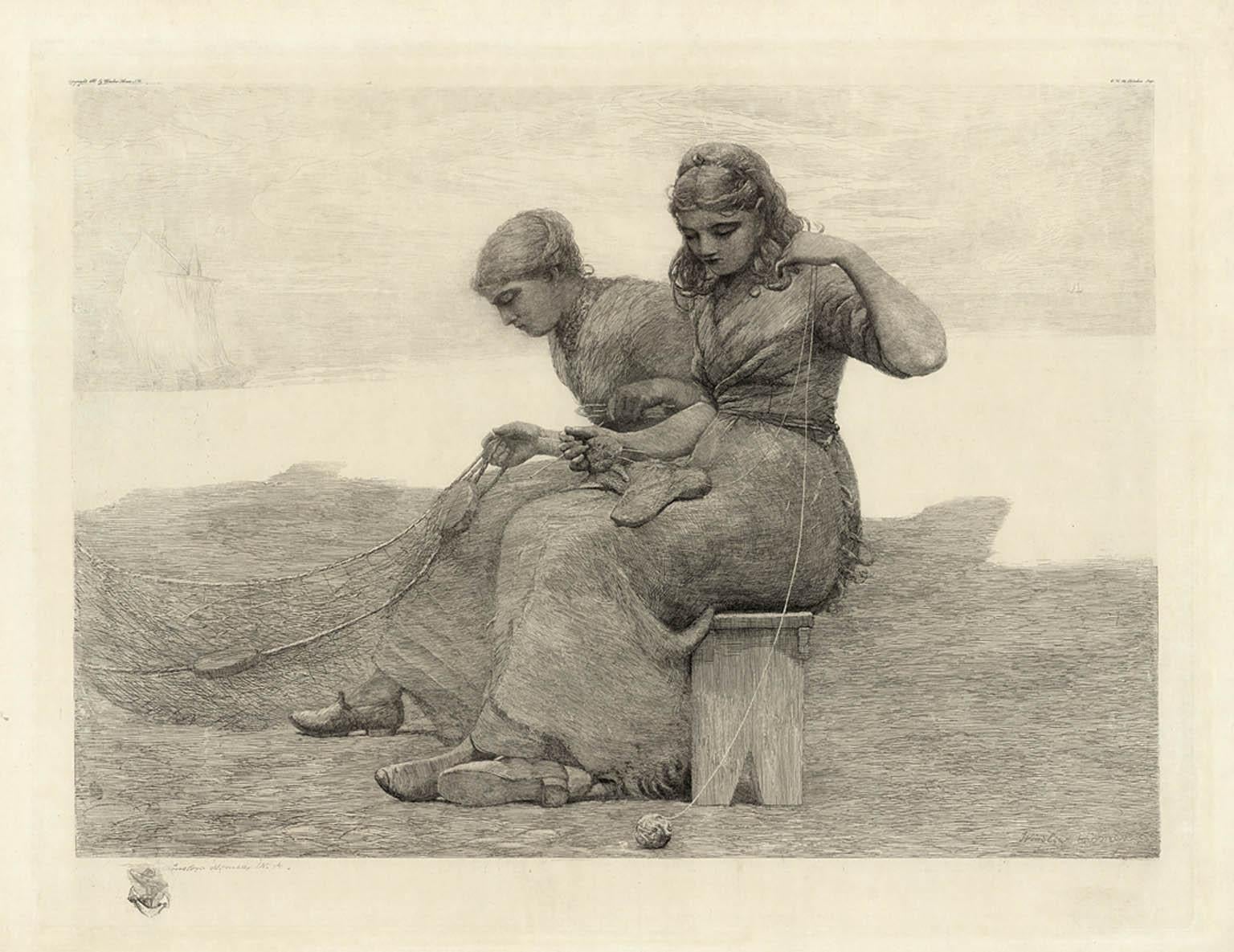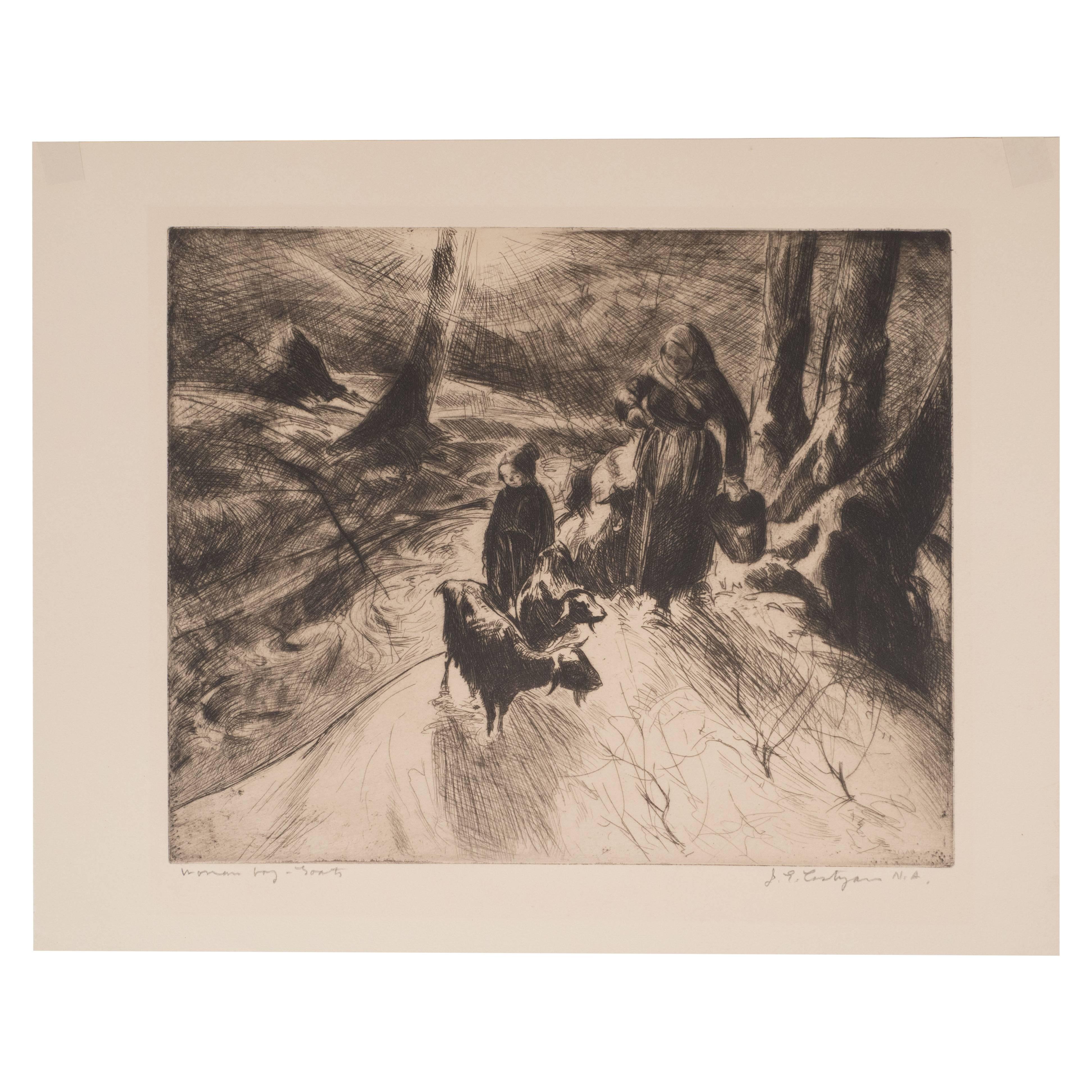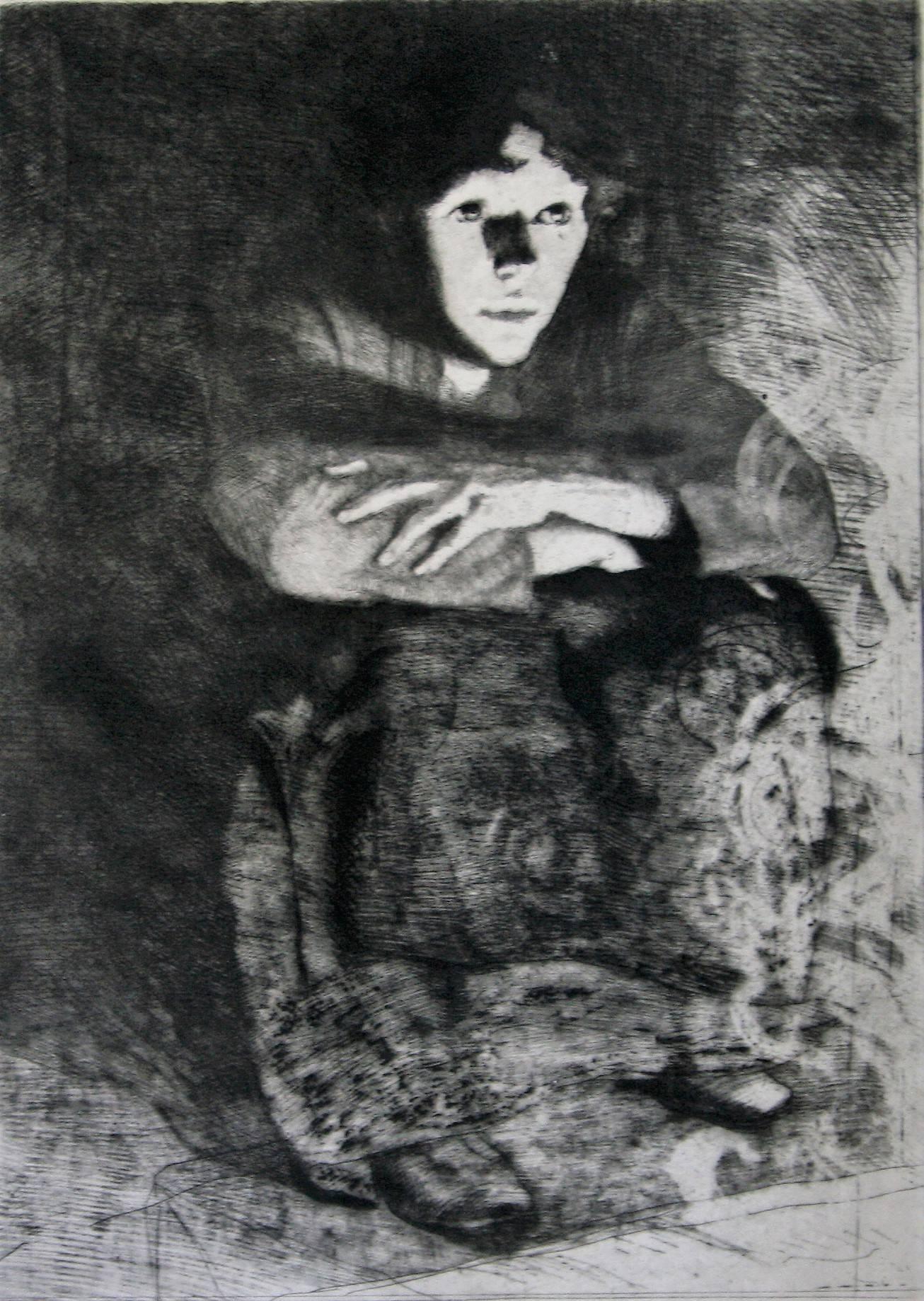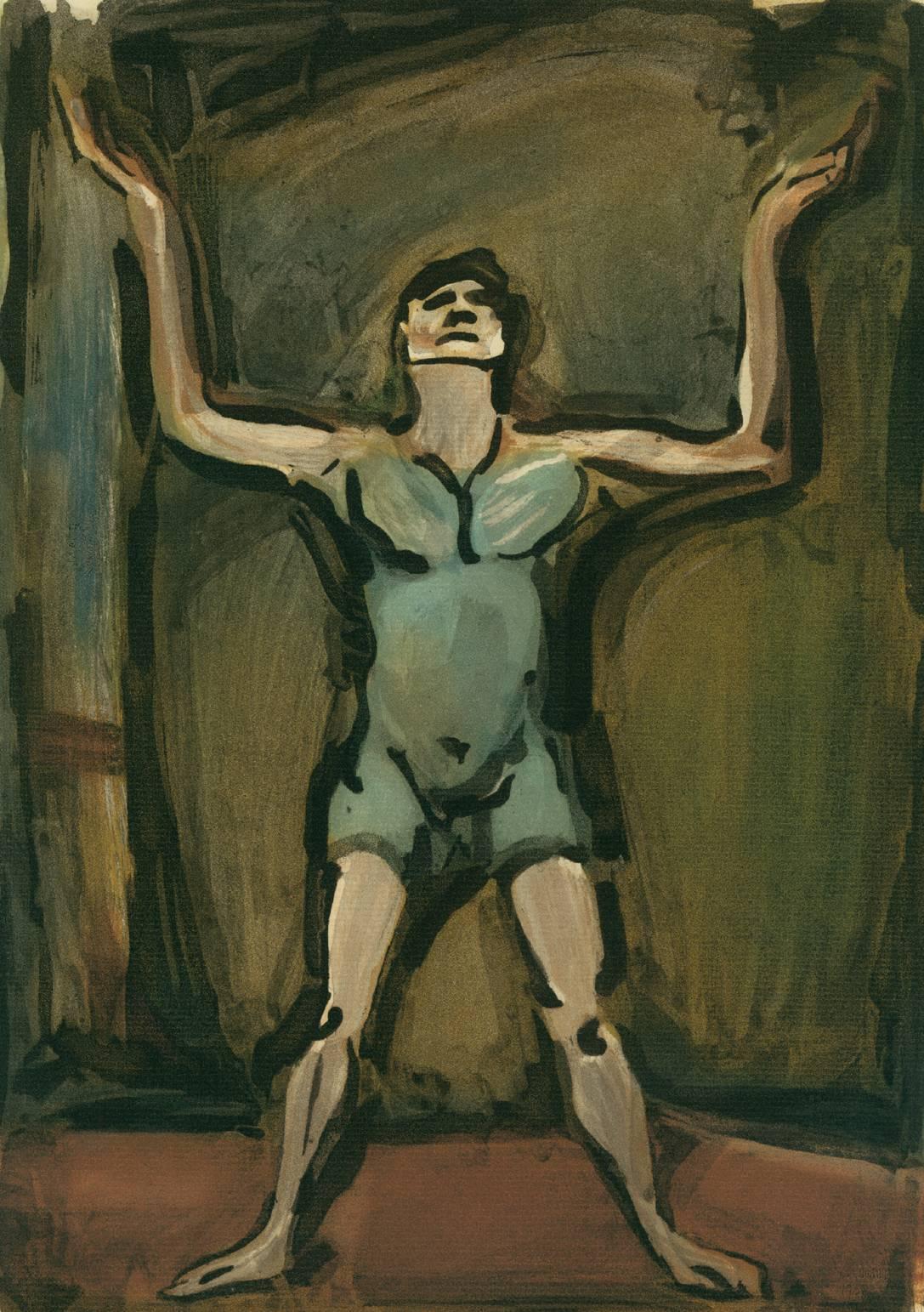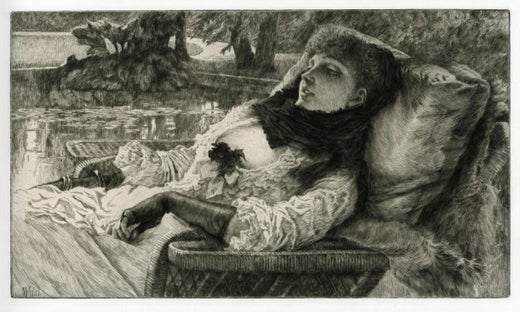Items Similar to L'enfant prodigue: en pays etranger (The Prodigal Son: In Foreign Climes)
Want more images or videos?
Request additional images or videos from the seller
1 of 10
James Jacques Joseph TissotL'enfant prodigue: en pays etranger (The Prodigal Son: In Foreign Climes)1881
1881
About the Item
L'enfant prodigue: en pays etranger (The Prodigal Son: In Foreign Climes)
Etching, 1881
Unsigned (as usual for this state)
From: L'enfant prodigue, (The Prodigal Son, five plates)
Edition: 400 in this state
Total edition: 500
Plate size: 12-1/4 x 14-3/4"
Sheet size: 19 5/8 x 24 1/2 "
Condition: Excellent, usual aging for 100 year old paper
Provenance: Heirs of Edmund Sagot, Paris
Reference: Wentworth 59 ii/II, with the title and caption
Tissot was the recent subject of a major retrospective organized by the Musee D'Orsay, Paris and the Fine Arts Museum of San Francisco. The following is excerpted from their press release:
"James Tissot (1836–1902) was one of the most celebrated French artists during the 19th century, yet he is less known than many of his contemporaries today. Presenting new scholarship on the artist’s oeuvre, technique, and remarkable life, James Tissot: Fashion & Faith provides a critical reassessment of Tissot through a 21st-century lens. The exhibition, co-organized by the Fine Arts Museums of San Francisco and the Musées d’Orsay et de l’Orangerie, Paris, includes approximately 60 paintings in addition to drawings, prints, photographs, and cloisonné enamels, demonstrating the breadth of the artist’s skills. The presentation at the Legion of Honor is the first major international exhibition on Tissot in two decades and the first ever on the West Coast of the United States.
“The work of James Tissot provides a fascinating lens onto society at the dawn of the modern era. Long recognized as a keen observer of contemporary life and fashion, this exhibition brings new light to his narrative strengths and his skill in portraying the emotional and spiritual undercurrents that exist below surface appearances,” states Thomas P. Campbell, Director and CEO of the Fine Arts Museums of San Francisco. “Continuing the Fine Arts Museums’ tradition of contributing original scholarship around key works in our collection, we are thrilled to introduce the perspective of this enigmatic, prolific artist in the first exhibition of his work to take place on the West Coast.”
Tissot’s works have been highly sought after for US collections, and, as such, James Tissot: Fashion & Faith draws from the rich holdings of the Fine Arts Museums of San Francisco; the J. Paul Getty Museum, Los Angeles; the National Gallery of Art, Washington, DC; and numerous private collections, in addition to private and public collections throughout Europe and Canada, including those of Tate, London; the Musées d’Orsay et de l’Orangerie; the Petit Palais, Musée des Beaux-Arts de la Ville de Paris; the Musée d’Arts de Nantes; the National Gallery of Canada, Ottawa; and the Musée des Beaux-Arts de Montréal. In addition, new findings on Tissot’s materials and painting technique—resulting from an extensive, unprecedented study of Tissot paintings and led by the paintings conservation department at the Fine Arts Museums—are revealed in the exhibition. The study was undertaken in collaboration with the Northwestern University/ Art Institute of Chicago Center for Scientific Studies in the Arts (NU-ACCESS) and the Centre for Research and Restoration of the Museums of France.
Arranged chrono-thematically, James Tissot: Fashion & Faithwill trace the extraordinary turns of the artist’s life, as he consistently defied traditional conventions, both professionally and personally. A Frenchman who started out painting medievalized scenes from history and literature, Tissot maintained a complicated friendship with mentee Edgar Degas, went on to adopt an Anglicized version of his name; Jacques, and spent a decade as an expatriate in London, immersing himself in and chronicling modern society. For a time, he ventured into a love affair with the young divorcée Kathleen Newton, who became his model and muse, but, after her tragic premature death, he returned to Paris and spent long periods of productive retreat at his family estate in the French countryside, nurturing a growing, deep commitment to religion.
Tissot’s career spanned the English Channel, garnering commercial and critical success both in London and Paris. Though invited by Degas to exhibit with the Impressionists, Tissot declined. He turned to social events and balls, painting metropolitan life with great attention to detail, humor, and pathos. Upon close study, even his most ebullient society pictures reveal rich and complex commentary on Belle Époque culture, religion, fashion, and politics. The exhibition will include many key modern-life works from his time in London and Paris, such as The Ball on Shipboard (1874), London Visitors (ca. 1874), Holyday (also known as The Picnic; 1876), The Prodigal Son in Modern Life suite (1882), and examples from the La Femme à Paris series (1883–1885).
“James Tissot was technically gifted across a variety of media and he experimented with major trends in art, including Aestheticism and Japonisme, yet his work defies classification and traditional labels,” notes Melissa Buron, exhibition curator and Director of the Art Division at the Fine Arts Museums of San Francisco. “For the past few years, my colleagues and I have been on the trail of Tissot, re-examining works and uncovering previously unpublished information that provides insight into his career, including his sales notebook (carnet de ventes) and hundreds of photographs. Drawing from our findings, James Tissot: Fashion & Faith provides new perspectives on where and how Tissot should be considered in the 19th-century canon.”
As was popular during the late 19th century, Tissot dabbled in mysticism and attended Spiritualist séances. His famous mezzotint from the Fine Arts Museums’ collection, The Apparition (1885), depicts the ghost of Kathleen Newton with a spirit guide as they reportedly appeared to Tissot during a séance. This work and the painting on which it is based—long thought to be lost or destroyed until it was rediscovered in the course of researching this project—are both on view in the exhibition.
Though less is known about the last two decades of Tissot’s life, new scholarship has recently shed light on the final 20 years of his career. During that time, he made three trips to the Holy Land and produced hundreds of watercolors to illustrate the Bible. Wildly popular during Tissot’s lifetime, these religious images became known as the “Tissot Bible” and have since influenced filmmakers from D. W. Griffith (Intolerance, 1916) to William Wyler (Ben-Hur, 1959), as well as Steven Spielberg and George Lucas (Raiders of the Lost Ark, 1981). A selection of biblical watercolors have been lent to the exhibition from the Brooklyn Museum and the Jewish Museum, New York.
Tissot also utilized the relatively new medium of photography by painting from photographs and recording many of his works as well as his home, family, and friends in carefully arranged albums. Photographs from the Fine Arts Museums’ collection in the exhibition, along with recently discovered, never-before-published photographs and a sales notebook published for the first time in the exhibition catalogue, provide a window into Tissot’s life and career, rendering him an artist worthy of reexamination in the 21st century."
- Creator:James Jacques Joseph Tissot (1836-1902, French)
- Creation Year:1881
- Dimensions:Height: 12.25 in (31.12 cm)Width: 14.75 in (37.47 cm)
- Medium:
- Movement & Style:
- Period:
- Condition:
- Gallery Location:Fairlawn, OH
- Reference Number:
James Jacques Joseph Tissot
Jacques Joseph Tissot (French: [tiso]; 15 October 1836 – 8 August 1902), Anglicized as James Tissot (), was a French painter and illustrator. He was a successful painter of Paris society before moving to London in 1871. He became famous as a genre painter of fashionably dressed women shown in various scenes of everyday life. He also painted scenes and figures from the Bible.
About the Seller
5.0
Recognized Seller
These prestigious sellers are industry leaders and represent the highest echelon for item quality and design.
Platinum Seller
These expertly vetted sellers are 1stDibs' most experienced sellers and are rated highest by our customers.
Established in 1978
1stDibs seller since 2013
713 sales on 1stDibs
Typical response time: 1 hour
Associations
International Fine Print Dealers Association
- ShippingRetrieving quote...Ships From: Fairlawn, OH
- Return PolicyA return for this item may be initiated within 10 days of delivery.
More From This SellerView All
- Au bord de la mer (At the Sea Side)By James Jacques Joseph TissotLocated in Fairlawn, OHAu bord de la mer (At the Sea Side) Etching and drypoint, 1880 Signed in the plate middle left edge (see photo) Edition: c. 100 A very rich impression, full of burr and contrasts Pri...Category
1880s Impressionist Figurative Prints
MaterialsEtching
- Keying Up - The Court JesterBy William Merritt ChaseLocated in Fairlawn, OHKeying Up - The Court Jester Etching with drypoint, 1879 Signed in the plate lower left corner (see photos) Proof before engraved title and engraved n...Category
1870s American Impressionist Figurative Prints
MaterialsEtching
- Noon Time LullBy Louis Oscar GriffithLocated in Fairlawn, OHNoon Time Lull Etching, c. 1930 Signed by the artist in pencil lower right (see photo) Note: An image done in South Carolina. An impression of this image is in the permanent collecti...Category
1930s American Impressionist Figurative Prints
MaterialsEtching
- Trois Esquisses de maternite (Three Studies of Maternity)By Pierre Auguste RenoirLocated in Fairlawn, OHAfter Pierre Auguste Renoir (1841-1919) Trois Esquisses de maternite (Three Studies of Maternity) Heliogravure with etching on velin paper, 1893 Unsigned as issued Edition 1000, there are also 100 on a different paper Note: The original red and white chalk drawing is in the collection of th Art Gallery of...Category
1890s Impressionist Figurative Prints
MaterialsEtching
- Afternoon Tea PartyBy (after) Mary CassattLocated in Fairlawn, OHAfternoon Tea Party Drypoint and aquatint printed in colors, printed 1991 Initialed in the center of the plate Condition: Excellent Archival framing with silk matting, finished corner gold...Category
1890s Impressionist Figurative Prints
MaterialsAquatint
- Daureen, IIBy Nell BlaineLocated in Fairlawn, OHDaureen, II Etching, 1969 Signed in pencil lower right Edition: 28 (17/28) Condition: Excellent Two hinges from previous matting Blaine studied etching at Atelier 17 in New York and considered one of their distinguished alums. "Blaine was foremost an abstract painter, first a student of Theresa Pollak...Category
1960s Impressionist Figurative Prints
MaterialsEtching
You May Also Like
- Mending the TearsBy Winslow HomerLocated in New York, NYWinslow Homer created this etching entitled “MENDING THE TEARS” in 1888. This is a lifetime impression signed by Homer and printed by the famous New York etcher George W. H. Ritchie...Category
1880s American Impressionist Figurative Prints
MaterialsEtching
- "Mother and Child" A Signed Limited Edition Etching by John E. CostiganBy John CostiganLocated in New York, NYThis original, limited edition etching, was realized by the esteemed American artist John E. Costigan, circa 1930. He is represented in the collections of the Metropolitan Museum, th...Category
1930s American Impressionist Figurative Prints
MaterialsEtching
- "Woman, Boy and Goats", Original Signed Etching by John E. CostiganBy John CostiganLocated in New York, NYThis original, limited edition etching, was realized by the esteemed American artist John E. Costigan, who is represented in the collections of the Metropolitan Museum, the Philips Memorial Gallery in Washington and the Brooklyn Museum, to name only a few of the many institutions that feature his work. This print, with its highly considered composition and its loose style of figuration- deftly balances realism and abstraction- helps to explain his acclaim. This etching features a mother walking with her child and two goats in a forested glen. It is a Classic pastoral scene rendered in Costigan's inimitable style- somewhere between Theodore Rousseau and Thomas Hart Benton. These offer a beautiful glimpse of a bygone American pastoral...Category
1930s American Impressionist Figurative Prints
MaterialsEtching
- In the Café - German Impressionism Berlin Society Cafe SceneBy Lesser UryLocated in London, GBThis original etching and drypoint is hand signed in pencil by the artist "L. Ury" at the lower left margin. It was published in an edition of 110 hand signed impressions by Propyläe...Category
1920s Impressionist Figurative Prints
MaterialsDrypoint, Etching
- Dans les Cendres (In the embers)By Albert BesnardLocated in Storrs, CTDans les Cendres (In the embers). 1887. Delteil catalog 67 state iii. State after the plate was cut down and a second figure eliminated (the two earlier states are of the greatest rarity). Etching, drypoint and roulette. 16 3/4 x 12 1/8 (sheet 19 1/2 x 14). Edition 50. Illustrated: Print Collector's Quarterly 9 (1921): 254. A very rich impression with plate tone and drypoint burr, printed on simili-japon. Provenance: Frederick Keppel & Co. This is one of the artist's most striking images. Signed in pencil. Housed in 25 x 20-inch archival mat, suitable for framing. Paul Albert Besnard, was an impressionist painter. In 1866, the seventeen-year-old son of artist parents began his studies at the École des Beaux-Arts Paris. In 1874, Besnard won the important Prix de Rome, with which the academy distinguished young talent. A portion of the scholarship is a stay of several years in Rome. Besnard married Charlotte Dubray, a sculptress, during this time in Rome. The couple lived in England, where Besnard exhibited at the Royal Academy London, between 1881 and 1884. He became involved with English portrait painting during this period, which had a lasting influence on his work. In the years that followed, Besnard broke with the academic tradition. In 1886, he presented the portrait of Madame Roger Jourdain...Category
Late 19th Century Impressionist Figurative Prints
MaterialsDrypoint, Etching
- Le Jongleur (The Minstrel)By Georges RouaultLocated in Storrs, CTLe Jongleur (The Minstrel). 1930. Etching and aquatint printed in colours. Chapon/Rouault 199 d. 12 1/4 x 8 1/2 (sheet 17 1/4 x 13 1/8). Series: Cirque plate 2. Edition 270. Initial...Category
Early 20th Century Impressionist Figurative Prints
MaterialsColor, Aquatint
Recently Viewed
View AllMore Ways To Browse
Tissot Trace
Luigi Rossini Column Of Trajan
M Aubry
Mens Cuban Heels
Nuremberg Chronicle
Original Offset Litho
Porte Interieur Antique
Purple Rain Poster
Raymond Pettibon On Sale
Red Bulls War Party
Tenor Sermon
The Oreo Happy Hour
The Spanish Forger
Tiffany And Co Jacksonville Fl
Tiffany And Co Palm Desert
Tiffany And Co Santa Monica
John Paradiso
Lichtenstein Mermaid
